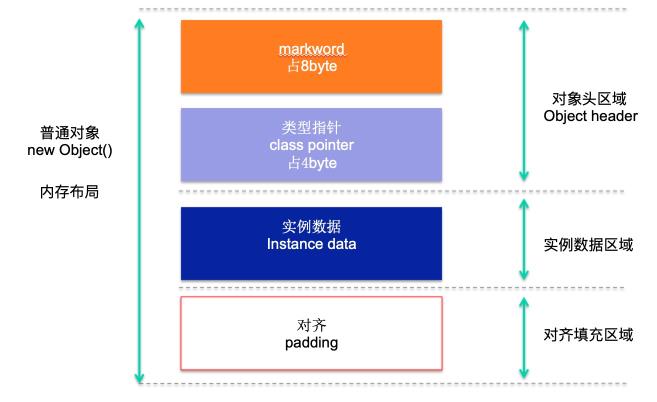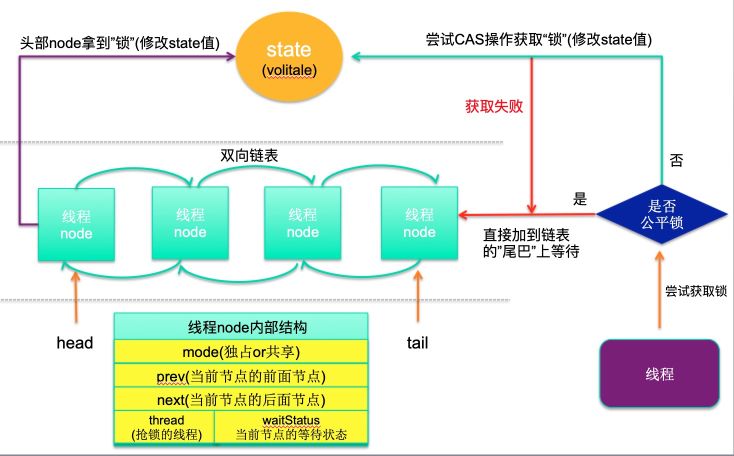一文详解 Java 的几把 JVM 级锁
Posted CSDN
tags:
篇首语:本文由小常识网(cha138.com)小编为大家整理,主要介绍了一文详解 Java 的几把 JVM 级锁相关的知识,希望对你有一定的参考价值。

作者 | 楚昭
来源 | 阿里巴巴中间件(ID:Aliware_2018)

synchronized



ReentrantLock


ReentrantReadWriteLock

/**
* 获取写锁
Acquires the write lock.
* 如果此时没有任何线程持有写锁或者读锁,那么当前线程执行CAS操作更新status,
* 若更新成功,则设置读锁重入次数为1,并立即返回
* <p>Acquires the write lock if neither the read nor write lock
* are held by another thread
* and returns immediately, setting the write lock hold count to
* one.
* 如果当前线程已经持有该写锁,那么将写锁持有次数设置为1,并立即返回
* <p>If the current thread already holds the write lock then the
* hold count is incremented by one and the method returns
* immediately.
* 如果该锁已经被另外一个线程持有,那么停止该线程的CPU调度并进入休眠状态,
* 直到该写锁被释放,且成功将写锁持有次数设置为1才表示获取写锁成功
* <p>If the lock is held by another thread then the current
* thread becomes disabled for thread scheduling purposes and
* lies dormant until the write lock has been acquired, at which
* time the write lock hold count is set to one.
*/
public void lock() {
sync.acquire(
1);
}
/**
* 该方法为以独占模式获取锁,忽略中断
* 如果调用一次该“tryAcquire”方法更新status成功,则直接返回,代表抢锁成功
* 否则,将会进入同步队列等待,不断执行“tryAcquire”方法尝试CAS更新status状态,直到成功抢到锁
* 其中“tryAcquire”方法在NonfairSync(公平锁)中和FairSync(非公平锁)中都有各自的实现
*
* Acquires in exclusive mode, ignoring interrupts. Implemented
* by invoking at least once {@link #tryAcquire},
* returning on success. Otherwise the thread is queued, possibly
* repeatedly blocking and unblocking, invoking {@link
* #tryAcquire} until success. This method can be used
* to implement method {@link Lock#lock}.
*
* @param arg the acquire argument. This value is conveyed to
* {@link #tryAcquire} but is otherwise uninterpreted and
* can represent anything you like.
*/
public final void acquire(int arg) {
if (!tryAcquire(arg) &&
acquireQueued(addWaiter(Node.EXCLUSIVE), arg))
selfInterrupt();
}
protected final boolean tryAcquire(int acquires) {
/*
* Walkthrough:
* 1、如果读写锁的计数不为0,且持有锁的线程不是当前线程,则返回false
* 1. If read count nonzero or write count nonzero
* and owner is a different thread, fail.
* 2、如果持有锁的计数不为0且计数总数超过限定的最大值,也返回false
* 2. If count would saturate, fail. (This can only
* happen if count is already nonzero.)
* 3、如果该锁是可重入或该线程在队列中的策略是允许它尝试抢锁,那么该线程就能获取锁
* 3. Otherwise, this thread is eligible for lock if
* it is either a reentrant acquire or
* queue policy allows it. If so, update state
* and set owner.
*/
Thread current = Thread.currentThread();
//获取读写锁的状态
int c = getState();
//获取该写锁重入的次数
int w = exclusiveCount(c);
//如果读写锁状态不为0,说明已经有其他线程获取了读锁或写锁
if (c !=
0) {
//如果写锁重入次数为0,说明有线程获取到读锁,根据“读写锁互斥”原则,返回false
//或者如果写锁重入次数不为0,且获取写锁的线程不是当前线程,根据"写锁独占"原则,返回false
// (Note: if c != 0 and w == 0 then shared count != 0)
if (w ==
0 || current != getExclusiveOwnerThread())
return
false;
//如果写锁可重入次数超过最大次数(65535),则抛异常
if (w + exclusiveCount(acquires) > MAX_COUNT)
throw
new Error(
"Maximum lock count exceeded");
//到这里说明该线程是重入写锁,更新重入写锁的计数(+1),返回true
// Reentrant acquire
setState(c + acquires);
return
true;
}
//如果读写锁状态为0,说明读锁和写锁都没有被获取,会走下面两个分支:
//如果要阻塞或者执行CAS操作更新读写锁的状态失败,则返回false
//如果不需要阻塞且CAS操作成功,则当前线程成功拿到锁,设置锁的owner为当前线程,返回true
if (writerShouldBlock() ||
!compareAndSetState(c, c + acquires))
return
false;
setExclusiveOwnerThread(current);
return
true;
}
/*
* Note that tryRelease and tryAcquire can be called by
* Conditions. So it is possible that their arguments contain
* both read and write holds that are all released during a
* condition wait and re-established in tryAcquire.
*/
protected final boolean tryRelease(int releases) {
//若锁的持有者不是当前线程,抛出异常
if (!isHeldExclusively())
throw new IllegalMonitorStateException();
//写锁的可重入计数减掉releases个
int nextc = getState() - releases;
//如果写锁重入计数为0了,则说明写锁被释放了
boolean free = exclusiveCount(nextc) == 0;
if (free)
//若写锁被释放,则将锁的持有者设置为null,进行GC
setExclusiveOwnerThread( null);
//更新写锁的重入计数
setState(nextc);
return free;
}
/**
* 获取读锁
* Acquires the read lock.
* 如果写锁未被其他线程持有,执行CAS操作更新status值,获取读锁后立即返回
* <p>Acquires the read lock if the write lock is not held by
* another thread and returns immediately.
*
* 如果写锁被其他线程持有,那么停止该线程的CPU调度并进入休眠状态,直到该读锁被释放
* <p>If the write lock is held by another thread then
* the current thread becomes disabled for thread scheduling
* purposes and lies dormant until the read lock has been acquired.
*/
public void lock() {
sync.acquireShared( 1);
}
/**
* 该方法为以共享模式获取读锁,忽略中断
* 如果调用一次该“tryAcquireShared”方法更新status成功,则直接返回,代表抢锁成功
* 否则,将会进入同步队列等待,不断执行“tryAcquireShared”方法尝试CAS更新status状态,直到成功抢到锁
* 其中“tryAcquireShared”方法在NonfairSync(公平锁)中和FairSync(非公平锁)中都有各自的实现
* (看这注释是不是和写锁很对称)
* Acquires in shared mode, ignoring interrupts. Implemented by
* first invoking at least once {@link #tryAcquireShared},
* returning on success. Otherwise the thread is queued, possibly
* repeatedly blocking and unblocking, invoking {@link
* #tryAcquireShared} until success.
*
* @param arg the acquire argument. This value is conveyed to
* {@link #tryAcquireShared} but is otherwise uninterpreted
* and can represent anything you like.
*/
public final void acquireShared(int arg) {
if (tryAcquireShared(arg) < 0)
doAcquireShared(arg);
}
protected final int tryAcquireShared(int unused) {
/*
* Walkthrough:
* 1、如果已经有其他线程获取到了写锁,根据“读写互斥”原则,抢锁失败,返回-1
* 1.If write lock held by another thread, fail.
* 2、如果该线程本身持有写锁,那么看一下是否要readerShouldBlock,如果不需要阻塞,
* 则执行CAS操作更新state和重入计数。
* 这里要注意的是,上面的步骤不检查是否可重入(因为读锁属于共享锁,天生支持可重入)
* 2. Otherwise, this thread is eligible for
* lock wrt state, so ask if it should block
* because of queue policy. If not, try
* to grant by CASing state and updating count.
* Note that step does not check for reentrant
* acquires, which is postponed to full version
* to avoid having to check hold count in
* the more typical non-reentrant case.
* 3、如果因为CAS更新status失败或者重入计数超过最大值导致步骤2执行失败
* 那就进入到fullTryAcquireShared方法进行死循环,直到抢锁成功
* 3. If step 2 fails either because thread
* apparently not eligible or CAS fails or count
* saturated, chain to version with full retry loop.
*/
//当前尝试获取读锁的线程
Thread current = Thread.currentThread();
//获取该读写锁状态
int c = getState();
//如果有线程获取到了写锁 ,且获取写锁的不是当前线程则返回失败
if (exclusiveCount(c) != 0 &&
getExclusiveOwnerThread() != current)
return -1;
//获取读锁的重入计数
int r = sharedCount(c);
//如果读线程不应该被阻塞,且重入计数小于最大值,且CAS执行读锁重入计数+1成功,则执行线程重入的计数加1操作,返回成功
if (!readerShouldBlock() &&
r < MAX_COUNT &&
compareAndSetState(c, c + SHARED_UNIT)) {
//如果还未有线程获取到读锁,则将firstReader设置为当前线程,firstReaderHoldCount设置为1
if (r == 0) {
firstReader = current;
firstReaderHoldCount = 1;
} else if (firstReader == current) {
//如果firstReader是当前线程,则将firstReader的重入计数变量firstReaderHoldCount加1
firstReaderHoldCount++;
} else {
//否则说明有至少两个线程共享读锁,获取共享锁重入计数器HoldCounter
//从HoldCounter中拿到当前线程的线程变量cachedHoldCounter,将此线程的重入计数count加1
HoldCounter rh = cachedHoldCounter;
if (rh == null || rh.tid != getThreadId(current))
cachedHoldCounter = rh = readHolds. get();
else if (rh.count == 0)
readHolds. set(rh);
rh.count++;
}
return 1;
}
//如果上面的if条件有一个都不满足,则进入到这个方法里进行死循环重新获取
return fullTryAcquireShared(current);
}
/**
* 用于处理CAS操作state失败和tryAcquireShared中未执行获取可重入锁动作的full方法(补偿方法?)
* Full version of acquire for reads, that handles CAS misses
* and reentrant reads not dealt with in tryAcquireShared.
*/
final int fullTryAcquireShared(Thread current) {
/*
* 此代码与tryAcquireShared中的代码有部分相似的地方,
* 但总体上更简单,因为不会使tryAcquireShared与重试和延迟读取保持计数之间的复杂判断
* This code is in part redundant with that in
* tryAcquireShared but is simpler overall by not
* complicating tryAcquireShared with interactions between
* retries and lazily reading hold counts.
*/
HoldCounter rh = null;
//死循环
for (;;) {
//获取读写锁状态
int c = getState();
//如果有线程获取到了写锁
if (exclusiveCount(c) != 0) {
//如果获取写锁的线程不是当前线程,返回失败
if (getExclusiveOwnerThread() != current)
return -1;
// else we hold the exclusive lock; blocking here
// would cause deadlock.
} else if (readerShouldBlock()) { //如果没有线程获取到写锁,且读线程要阻塞
// Make sure we're not acquiring read lock reentrantly
//如果当前线程为第一个获取到读锁的线程
if (firstReader == current) {
// assert firstReaderHoldCount > 0;
} else { //如果当前线程不是第一个获取到读锁的线程(也就是说至少有有一个线程获取到了读锁)
//
if (rh == null) {
rh = cachedHoldCounter;
if (rh == null || rh.tid != getThreadId(current)) {
rh = readHolds. get();
if (rh.count == 0)
readHolds. remove();
}
}
if (rh.count == 0)
return -1;
}
}
/**
*下面是既没有线程获取写锁,当前线程又不需要阻塞的情况
*/
//重入次数等于最大重入次数,抛异常
if (sharedCount(c) == MAX_COUNT)
throw new Error( "Maximum lock count exceeded");
//如果执行CAS操作成功将读写锁的重入计数加1,则对当前持有这个共享读锁的线程的重入计数加1,然后返回成功
if (compareAndSetState(c, c + SHARED_UNIT)) {
if (sharedCount(c) == 0) {
firstReader = current;
firstReaderHoldCount = 1;
} else if (firstReader == current) {
firstReaderHoldCount++;
} else {
if (rh == null)
rh = cachedHoldCounter;
if (rh == null || rh.tid != getThreadId(current))
rh = readHolds. get();
else if (rh.count == 0)
readHolds. set(rh);
rh.count++;
cachedHoldCounter = rh; // cache for release
}
return 1;
}
}
}
/**
* Releases in shared mode. Implemented by unblocking one or more
* threads if {@link #tryReleaseShared} returns true.
*
* @param arg the release argument. This value is conveyed to
* {@link #tryReleaseShared} but is otherwise uninterpreted
* and can represent anything you like.
* @return the value returned from {@link #tryReleaseShared}
*/
public final boolean releaseShared(int arg) {
if (tryReleaseShared(arg)) {
//尝试释放一次共享锁计数
doReleaseShared();
//真正释放锁
return
true;
}
return
false;
}
/**
*此方法表示读锁线程释放锁。
*首先判断当前线程是否为第一个读线程firstReader,
*若是,则判断第一个读线程占有的资源数firstReaderHoldCount是否为1,
若是,则设置第一个读线程firstReader为空,否则,将第一个读线程占有的资源数firstReaderHoldCount减1;
若当前线程不是第一个读线程,
那么首先会获取缓存计数器(上一个读锁线程对应的计数器 ),
若计数器为空或者tid不等于当前线程的tid值,则获取当前线程的计数器,
如果计数器的计数count小于等于1,则移除当前线程对应的计数器,
如果计数器的计数count小于等于0,则抛出异常,之后再减少计数即可。
无论何种情况,都会进入死循环,该循环可以确保成功设置状态state
*/
protected final boolean tryReleaseShared(int unused) {
// 获取当前线程
Thread current = Thread.currentThread();
if (firstReader == current) {
// 当前线程为第一个读线程
// assert firstReaderHoldCount > 0;
if (firstReaderHoldCount ==
1)
// 读线程占用的资源数为1
firstReader =
null;
else
// 减少占用的资源
firstReaderHoldCount--;
}
else {
// 当前线程不为第一个读线程
// 获取缓存的计数器
HoldCounter rh = cachedHoldCounter;
if (rh ==
null || rh.tid != getThreadId(current))
// 计数器为空或者计数器的tid不为当前正在运行的线程的tid
// 获取当前线程对应的计数器
rh = readHolds.get();
// 获取计数
int count = rh.count;
if (count <=
1) {
// 计数小于等于1
// 移除
readHolds.remove();
if (count <=
0)
// 计数小于等于0,抛出异常
throw unmatchedUnlockException();
}
// 减少计数
--rh.count;
}
for (;;) {
// 死循环
// 获取状态
int c = getState();
// 获取状态
int nextc = c - SHARED_UNIT;
if (compareAndSetState(c, nextc))
// 比较并进行设置
// Releasing the read lock has no effect on readers,
// but it may allow waiting writers to proceed if
// both read and write locks are now free.
return nextc ==
0;
}
}
/**真正释放锁
* Release action for shared mode -- signals successor and ensures
* propagation. (Note: For exclusive mode, release just amounts
* to calling unparkSuccessor of head if it needs signal.)
*/
private void doReleaseShared() {
/*
* Ensure that a release propagates, even if there are other
* in-progress acquires/releases. This proceeds in the usual
* way of trying to unparkSuccessor of head if it needs
* signal. But if it does not, status is set to PROPAGATE to
* ensure that upon release, propagation continues.
* Additionally, we must loop in case a new node is added
* while we are doing this. Also, unlike other uses of
* unparkSuccessor, we need to know if CAS to reset status
* fails, if so rechecking.
*/
for (;;) {
Node h = head;
if (h !=
null && h != tail) {
int ws = h.waitStatus;
if (ws == Node.SIGNAL) {
if (!compareAndSetWaitStatus(h, Node.SIGNAL,
0))
continue;
// loop to recheck cases
unparkSuccessor(h);
}
else
if (ws ==
0 &&
!compareAndSetWaitStatus(h,
0, Node.PROPAGATE))
continue;
// loop on failed CAS
}
if (h == head)
// loop if head changed
break;
}
}

LongAdder

以上是关于一文详解 Java 的几把 JVM 级锁的主要内容,如果未能解决你的问题,请参考以下文章